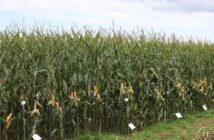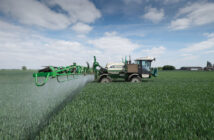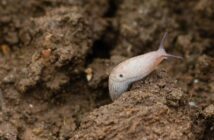Seven new first-choice varieties have been added to the British Society of Plant Breeder’s 2016 Forage Maize Descriptive Lists (DL), alongside five new varieties on the Forage Maize for Anaerobic Digestion DLs.
The varieties Coditank and Emmerson from DLF and Augustus KWS, Rodriguez KWS and Rubiera KWS from KWS have been added to the Forage Maize DLs for favourable and less-favourable sites. Vandiamond from Momont is added to the DL for favourable sites. Perez KWS from KWS is added to the DL for less-favourable sites.
In addition to the seven new varieties, five more have been reclassified to the first choice less-favourable DL, aimed at sites with ‘marginal’ growing conditions. These are Asgaard from Limagrain, Monty from DLF, Hobbit and Dualto from Grainseed and Kougar from KWS.
NIAB TAG’s forage crop specialist and the DL trials manager Simon Kerr believes that all forage maize growers will benefit from the new additions. “These varieties offer a range of valuable characteristics within a wide range of maturity, spanning from 29.6 to 38.3% dry matter content on the DL for favourable sites.”
New first choice varieties for favourable sites
On the DL for favourable sites, Emmerson, Augustus KWS and Rubiera KWS all have early maturity with impressive yield potential and high starch yields, and are suitable for early harvests. Vandiamond is at the late end of the maturity group and has shown exceptionally high dry matter yields combined with significantly above average levels of ME and starch. However, severe brackling was recorded with this variety at one trial in one season. Coditank is also later maturing with above average dry matter yield, ME and starch.
New first choice varieties for less-favourable sites
For the DL less-favourable sites the three new early varieties Emmerson, Augustus KWS and Rubiera KWS all have merit due to their combination of above average dry matter yields and early maturity. Perez KWS has high dry matter yield which compensates for below average ME and starch levels. Rodriguez KWS produces above average performance from these sites as does Coditank.
First choice varieties for favourable sites
Summarising the complete lists Mr Kerr highlights that there are 29 first-choice varieties for favourable sites. “Of the earliest maturing varieties, those with greater than 35% dry matter content, Glory and Emmerson have the highest yield potential. Activate, Rubiera KWS and Ramirez have significantly above average ME levels and in the group with dry matter levels ranging between 30% and 35%, Ambition, Kougar and Rodriguez KWS have the highest dry matter yield potential. Sunlite combines above average yield with very high ME, starch and cell wall digestibility and of the later maturing varieties all have above average yield potential with high ME and starch from Vandiamond and Emblem.”
First choice varieties for less-favourable sites
The DL for less-favourable sites has 26 varieties included. Here the emphasis should be on early maturity coupled with good ME and starch levels. From the earliest group, Activate and Rubiera KWS show a strong balance of characters with high ME levels and cell wall digestibility coupled with above average yields. From the less early maturing group Rodriguez KWS, Emblem, Sunlite and Glory are strong performers with Sunlite again showing good quality characteristics. For growers willing to risk later maturity then Asgaard and Hobbit have the highest yield potential.
BSPB technical manager Jeremy Widdowson explains that growers continue to benefit from the inclusion of variety resistance ratings to maize eyespot (Aureobasidium zeae formally known as Kabatiella zeae) with ratings published for more varieties. The ratings were included for the first time last year.
“The disease can severely affect yields due to early die-back and the ratings may be an invaluable aid to selection for concerned growers in a susceptible area. It is a disease favoured by wet conditions and can be more prevalent in the west and south of the UK,” says Mr Widdowson.
Eyespot ratings on the Lists range from 2.7 to 7.6 based on a 1-9 scale (where 9 denotes high resistance), with the data derived from inoculated nurseries rather than natural infection scores to provide the most reliable information.
Biogas Maize
The 2016 Forage Maize for Anaerobic Digestion (AD) Descriptive List for favourable sites has 20 varieties, with five new listings of ES Heracles and Monty from DLF, Cathy and ES Bodyguard from Grainseed, and Pirro from Germinal. The List for less-favourable sites includes the same five new varieties with 16 in total.
The varieties on the 2016 Lists have been nominated by the plant breeders and are all suitable for biogas producers growing and using the crop as a feedstock. The Lists aims to aid variety selection as producers can check energy output in the form of metabolisable energy (ME) and other traits such as dry matter content and yield, early vigour and standing power.
The BSPB 2016 ‘Forage Maize’ and ‘Forage Maize for AD’ Descriptive Lists are available to download from the BSPB website (www.bspb.co.uk) and NIAB (www.niab.com) websites.



